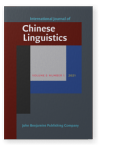Vol. 8:1 (2021) ► pp.1–34
On indefinite subjects in Mandarin
A semantic account
This study investigates the licensing conditions and interpretational variability of indefinite subjects in Mandarin. Against the ‘definiteness’ constraint of subject in Mandarin (Chao 1968; Li and Thompson 1981), three types of indefinite subjects are identified in the subject position, but they exhibit different scope behaviors: (i) you-nominals are ambiguous between a wide scope and a narrow scope, and (ii) thetic subjects are narrow-scope taking, and (iii) ‘cardinal’ subjects are scopeless. Following Cohen and Erteschik-Shir (2002), we propose that the former two types of indefinite subjects are focus elements and they fall into the position of nuclear scope, where they receive an existential interpretation, and cardinal subjects are topics and they serve as restrictor to some generic operator. Moreover, the wide/narrow scope readings of you-nominals are distinguished from each other in terms of whether a topic domain is available or not, which may serve a domain restrictor to the existential quantifier bound to you-nominals (Portner 2002).
Article outline
- 1.The issues
- 2.What are the facts of indefinite subject?
- 2.1Individual-denoting nominals with or without YOU
- 2.2Quantity-denoting nominals
- 2.3A unified analysis: A feature-checking approach
- 3.Scopal behaviors of indefinite subjects
- 3.1Scope of individual-denoting nominals with or without YOU
- 3.2Scope of quantity-denoting nominals
- 4.Correlating indefinite subjects with topic/focus
- 4.1Cohen and Erteschik-Shir’s account
- 4.2Indefinite subjects with an existential or a generic reading
- 5.Semantics of cardinal subjects in modal sentences
- 5.1Modal sentences with cardinal subject as generic sentences
- 5.2Group reading and cumulativity
- 5.3Teasing apart modality and genericity: A modal-based analysis of genericity
- 6.Conclusions
- Acknowledgements
- Notes
- The abbreviations used in this article are enumerated as follows
-
References
